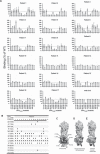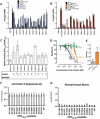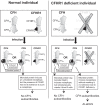The major autoantibody epitope on factor H in atypical hemolytic uremic syndrome is structurally different from its homologous site in factor H-related protein 1, supporting a novel model for induction of autoimmunity in this disease
- PMID: 25659429
- PMCID: PMC4392255
- DOI: 10.1074/jbc.M114.630871
The major autoantibody epitope on factor H in atypical hemolytic uremic syndrome is structurally different from its homologous site in factor H-related protein 1, supporting a novel model for induction of autoimmunity in this disease
Abstract
Atypical hemolytic uremic syndrome (aHUS) is characterized by complement attack against host cells due to mutations in complement proteins or autoantibodies against complement factor H (CFH). It is unknown why nearly all patients with autoimmune aHUS lack CFHR1 (CFH-related protein-1). These patients have autoantibodies against CFH domains 19 and 20 (CFH19-20), which are nearly identical to CFHR1 domains 4 and 5 (CFHR14-5). Here, binding site mapping of autoantibodies from 17 patients using mutant CFH19-20 constructs revealed an autoantibody epitope cluster within a loop on domain 20, next to the two buried residues that are different in CFH19-20 and CFHR14-5. The crystal structure of CFHR14-5 revealed a difference in conformation of the autoantigenic loop in the C-terminal domains of CFH and CFHR1, explaining the variation in binding of autoantibodies from some aHUS patients to CFH19-20 and CFHR14-5. The autoantigenic loop on CFH seems to be generally flexible, as its conformation in previously published structures of CFH19-20 bound to the microbial protein OspE and a sialic acid glycan is somewhat altered. Cumulatively, our data suggest that association of CFHR1 deficiency with autoimmune aHUS could be due to the structural difference between CFHR1 and the autoantigenic CFH epitope, suggesting a novel explanation for CFHR1 deficiency in the pathogenesis of autoimmune aHUS.
Keywords: Atypical Hemolytic Uremic Syndrome; Autoimmune Disease; Autoimmunity; Complement Regulation; Immunoglobulin G (IgG); Immunology; Structure-Function Study; Thrombotic Microangiopathy; X-ray Crystallography.
© 2015 by The American Society for Biochemistry and Molecular Biology, Inc.
Figures






Similar articles
-
Complement factor H, FHR-3 and FHR-1 variants associate in an extended haplotype conferring increased risk of atypical hemolytic uremic syndrome.Mol Immunol. 2015 Oct;67(2 Pt B):276-86. doi: 10.1016/j.molimm.2015.06.021. Epub 2015 Jul 7. Mol Immunol. 2015. PMID: 26163426
-
Complement factor H-related protein 1 deficiency and factor H antibodies in pediatric patients with atypical hemolytic uremic syndrome.Clin J Am Soc Nephrol. 2013 Mar;8(3):407-15. doi: 10.2215/CJN.01260212. Epub 2012 Dec 14. Clin J Am Soc Nephrol. 2013. PMID: 23243267 Free PMC article.
-
Atypical hemolytic uremic syndrome associated with complement factor H autoantibodies and CFHR1/CFHR3 deficiency.Pediatr Res. 2009 Sep;66(3):336-40. doi: 10.1203/PDR.0b013e3181b1bd4a. Pediatr Res. 2009. PMID: 19531976
-
Shiga toxin-producing Escherichia coli infection as a precipitating factor for atypical hemolytic-uremic syndrome.Pediatr Nephrol. 2025 Feb;40(2):449-461. doi: 10.1007/s00467-024-06480-9. Epub 2024 Sep 30. Pediatr Nephrol. 2025. PMID: 39347991 Free PMC article. Review.
-
Complement factor H-antibody-associated hemolytic uremic syndrome: pathogenesis, clinical presentation, and treatment.Semin Thromb Hemost. 2014 Jun;40(4):431-43. doi: 10.1055/s-0034-1375297. Epub 2014 May 5. Semin Thromb Hemost. 2014. PMID: 24799303 Review.
Cited by
-
Interaction of the Factor H Family Proteins FHR-1 and FHR-5 With DNA and Dead Cells: Implications for the Regulation of Complement Activation and Opsonization.Front Immunol. 2020 Jul 16;11:1297. doi: 10.3389/fimmu.2020.01297. eCollection 2020. Front Immunol. 2020. PMID: 32765490 Free PMC article.
-
Variants in complement genes are uncommon in patients with anti-factor H autoantibody-associated atypical hemolytic uremic syndrome.Pediatr Nephrol. 2023 Aug;38(8):2659-2668. doi: 10.1007/s00467-022-05862-1. Epub 2023 Jan 9. Pediatr Nephrol. 2023. PMID: 36622444
-
Complement in hemolytic anemia.Blood. 2015 Nov 26;126(22):2459-65. doi: 10.1182/blood-2015-06-640995. Epub 2015 Nov 18. Blood. 2015. PMID: 26582375 Free PMC article. Review.
-
Association among Complement Factor H Autoantibodies, Deletions of CFHR, and the Risk of Atypical Hemolytic Uremic Syndrome.Int J Environ Res Public Health. 2016 Dec 5;13(12):1209. doi: 10.3390/ijerph13121209. Int J Environ Res Public Health. 2016. PMID: 27929404 Free PMC article.
-
Factor H-related protein 1 in systemic lupus erythematosus.Front Immunol. 2024 Jul 29;15:1447991. doi: 10.3389/fimmu.2024.1447991. eCollection 2024. Front Immunol. 2024. PMID: 39136026 Free PMC article.
References
-
- Noris M., Remuzzi G. (2009) Atypical hemolytic-uremic syndrome. N. Engl. J. Med. 361, 1676–1687 - PubMed
-
- Sánchez-Corral P., Melgosa M. (2010) Advances in understanding the aetiology of atypical haemolytic uraemic Syndrome. Br. J. Haematol 150, 529–542 - PubMed
-
- Zipfel P. F., Edey M., Heinen S., Józsi M., Richter H., Misselwitz J., Hoppe B., Routledge D., Strain L., Hughes A. E., Goodship J. A., Licht C., Goodship T. H., Skerka C. (2007) Deletion of complement factor H-related genes CFHR1 and CFHR3 is associated with atypical hemolytic uremic syndrome. PLoS Genet 3, e41. - PMC - PubMed
-
- Venables J. P., Strain L., Routledge D., Bourn D., Powell H. M., Warwicker P., Diaz-Torres M. L., Sampson A., Mead P., Webb M., Pirson Y., Jackson M. S., Hughes A., Wood K. M., Goodship J. A., Goodship T. H. (2006) Atypical haemolytic uraemic syndrome associated with a hybrid complement gene. PLoS Med. 3, e431. - PMC - PubMed
Publication types
MeSH terms
Substances
Associated data
- Actions
LinkOut - more resources
Full Text Sources
Molecular Biology Databases
Research Materials
Miscellaneous

